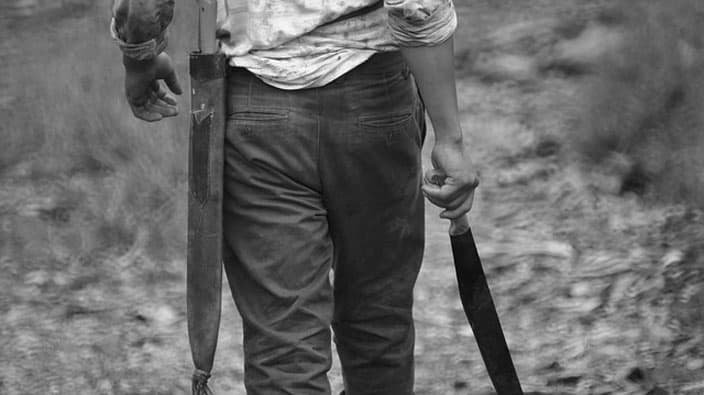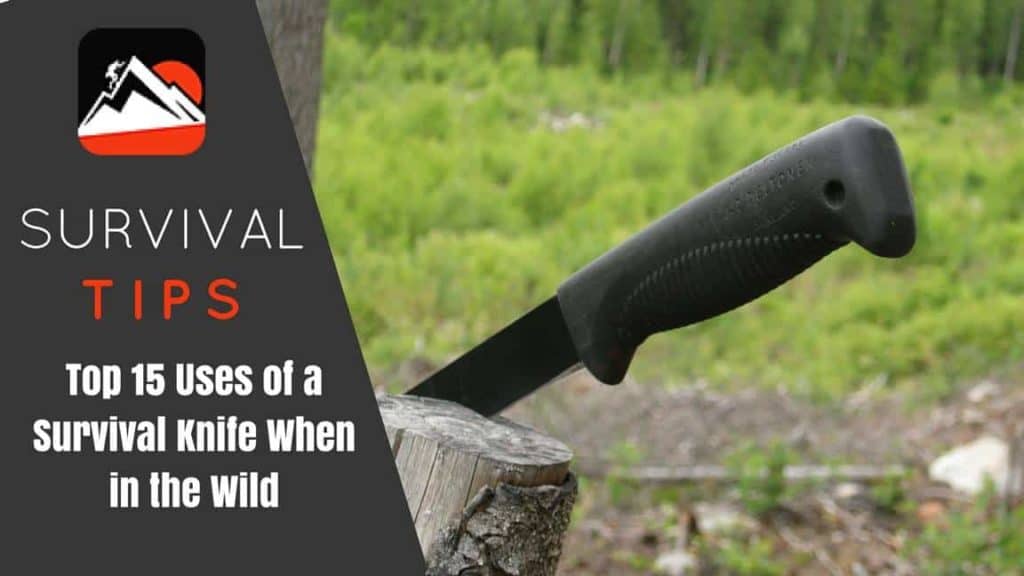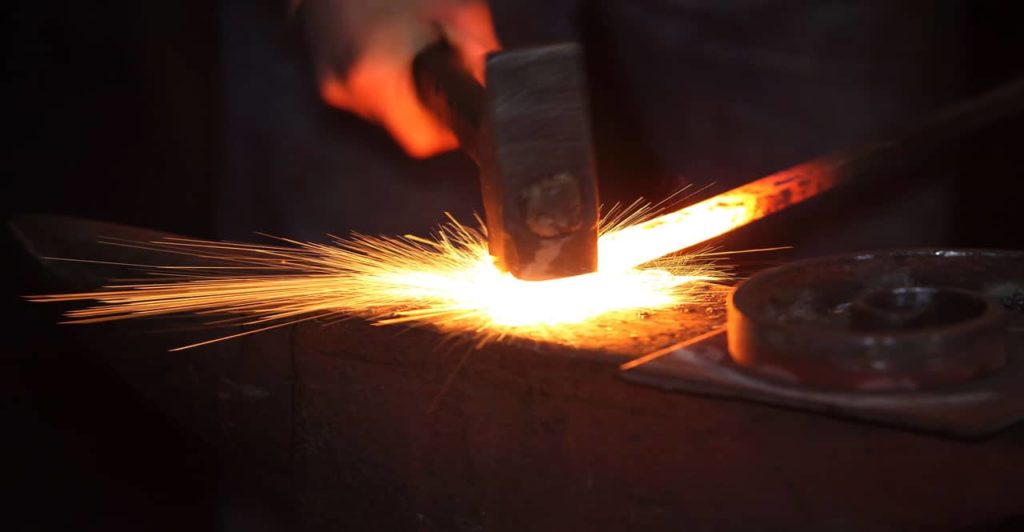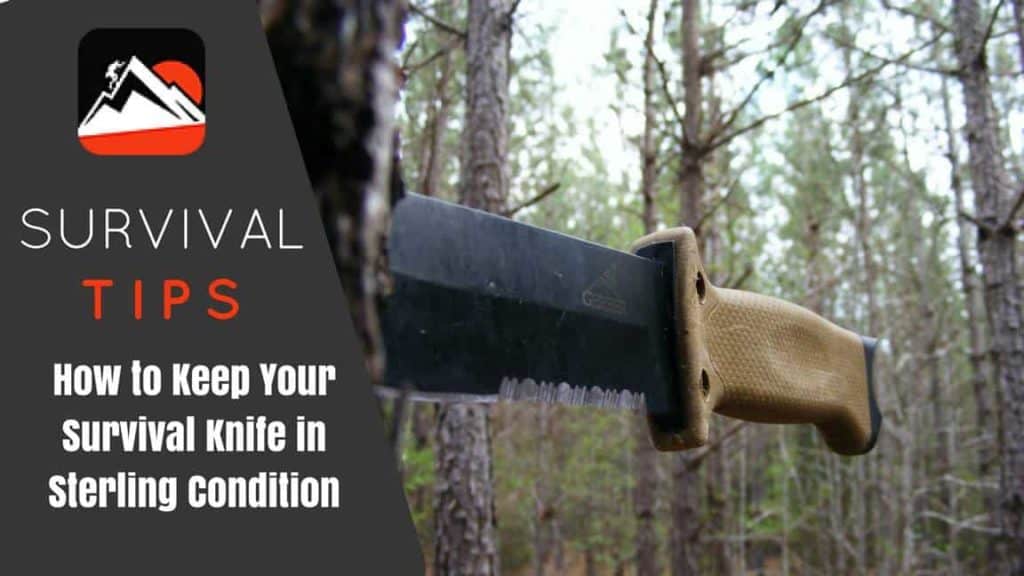Contents
As I mentioned in my article on Kukri knives, I have always been fascinated with ethnic knife designs and the Parang is no exception. Similar in purpose but not in design to the South American Machete, the Parang is a Malaysian ethnic knife design with a very unusual blade design that typically ranges in length from 10 to 36 inches in length. However, because the vegetation in Southeast Asia is typically quite a bit tougher than that found in South America, Parangs usually feature a significantly thicker blade construction. In addition, unlike the Machete, the Parang typically has a continuously curved cutting edge with a back that matches the curve of the edge but which ends in a rather blunt clip point or drop point. Furthermore, unlike the South American Machete which typically features a saber grind along its entire edge, the Malaysian version of the Parang typically has a Convex Grind in order to prevent the blade from binding in woody vegetation when chopping. Plus, because the Parang is often used as a general purpose utility knife, the edge typically features three different zones which serve different purposes. Therefore, the front part of the edge is generally kept very sharp for use as a skinning knife while the middle of the blade is used for chopping and is consequently kept less sharp while the back of the edge is sharpened to a very fine edge for carving. In this guide, we give you the most important tips you need to consider when buying the best parang machete for your needs.
You might find interesting to read our best Cold Steel machetes article.
Parang Buyer’s Guide
While perhaps not as well known as the Nepalese Kukri, the Malaysian Parang is also designed to be a general purpose utility knife and thus, the length of the blade can vary from relatively short to relatively long depending on the user’s intended purpose for the knife. In addition, the blade thickness and overall weight can also vary widely. However, the Parang’s continuously curved cutting edge is not only easier to sharpen than the recurved edge of the Khukuri, it is easier to use for general purpose bushcraft tasks and camp chores. Therefore, many avid outdoorsmen prefer the Parang over the Kukri for general purpose use. On the other hand, even though the Parang features a positive blade angle similar to the Kukri, the extreme weight forward design and deep belly of the Kukri make it a more effective heavy duty chopping tool than the Parang.
Thus, it should be noted that the shorter a Parang’s blade is the more control the user will have over it while, the longer a Parang’s blade, the less control the user will have over it. But, at the same time, the shorter a Parang’s blade is, the less effective it will be as a chopping tool while, the longer a Parang’s blade is, the more effective a chopping tool it will be.
In addition, when considering the purchase of a particular Parang, there are several other aspects that you should be aware of and keep in mind such as the type of steel that the blade is made from, it’s Rockwell Hardness, the type of tang design it has, the width of the blade’s spine and, the overall weight of the knife.
- Blade steels – Due to the fact that a discussion of blade steels is both complicated and deep, I will only provide a brief explanation here as it relates to the Parang. Thus, you should first be aware that blade steels are commonly divided into stainless steels and high carbon plain tool steels and, they each have properties that make them best suited for constructing certain types of knives. For instance, although stainless steels are highly corrosion resistant due to their Chromium content, the addition of Chromium to steel also increases it grain size which weakens it. Therefore, metallurgists add other elements such as Manganese and Vanadium to refine the grain structure. On the other hand, plain tool steels generally lack the addition of Chromium and instead contain only Carbon and Manganese in addition to the steel which gives them a very fine grain structure. Therefore, plain tool steels are commonly stronger and tougher than stainless steels. But, due to their lack of Chromium, they are not corrosion resistant and thus, they require significantly more care to keep them corrosion free. Consequently, plain tool steels are generally a better choice for large, heavy-duty, knives than stainless steels are.
- Rockwell Hardness – The Rockwell Hardness of the blade is another factor that should be considered when contemplating the purchase of a Khukuri. FYI, the Rockwell C scale is commonly used to measure the hardness of blade steels and this factor is important because toughness and hardness tend to be mutually exclusive. Thus, blade steels with a lower Rockwell Hardness tend to be stronger and tougher than blade steels with a higher Rockwell Hardness and thus, they tend to do a better job of withstanding the shock generated by chopping hard materials such as wood. But, at the same time, blade steels with a lower Rockwell Hardness don’t hold an edge as well as blade steels with a higher Rockwell Hardness and thus, they need to be sharpened more often. Consequently, blade steels with a Rockwell Hardness of 45 are considered to be relatively soft whereas, blade steels with a Rockwell Hardness of 50 to 55 are considered to be a good compromise between a tough steel and a hard steel whereas, blade steels with a Rockwell hardness of 60 are considered to be relatively hard.
- Tang Design – Yet another factor that should be considered when purchasing a Parang is the design of its tang which is the part of the blade to which the handle is attached. Also, you should be aware that there are several different types of tang designs ranging from full tangs to stick tangs and the main difference between them is their relative strength. Thus, full tangs are the strongest design with hidden tangs being the next strongest design and partial tangs being the third strongest design. Thus, because most Parangs are specifically designed to be heavy duty chopping tools, you should look for a Parang with either a full tang or a hidden tang design.
- Spine Thickness – A fourth factor that you should consider when purchasing a Parang is the thickness of its spine. For those of you who are not familiar with this term, a knife blade’s spine is the thickest part of the blade and, in the case of Parangs due to their flat or saber grinds, the blade’s spine is the same as the back of the knife (the side opposite of the cutting edge). Thus, this factor of blade design is important when choosing a Parang because the thicker the blade’s spine is, the stronger the blade will be.
- Overall weight – The last factor that you should consider when purchasing a Parang is its overall weight which is, in turn, related to its spine thickness. For instance, the thicker a Parang’s spine is, the thicker the bar stock from which it is constructed and thus, the heavier it is likely to be depending on the blade grind. Also, the heavier a Parang is, the more momentum it will have when swung and thus, the more deeply it will penetrate. But, it should also be noted that the heavier a Parang is, the less control the user will have over it when using it for more delicate cutting tasks while the lighter it is, the more control the user will have when performing delicate cutting tasks.
Consequently, when purchasing a Parang, it is important to first determine what your main use of the knife is. For instance, for utilitarian use around camp, a Parang with a shorter, lighter, more controllable blade and a less sharply dropped or angled back would be most useful while, for clearing campsites, chopping firewood, and other heavy-duty camp tasks, a Parang with a longer, more sharply dropped or angled back would be more useful. In addition, Parangs with thinner spines are lighter and thus, more controllable but have less chopping ability while Parangs with thicker spines are heavier and thus, are less controllable but, they have greater chopping ability. So, it is important to choose your Parang according to the task for which you intend to use it most often.
Check out our suggested kukri machetes article.
The Top Five Western Parangs
Because the Malaysian Parang is specifically designed to be both a general-purpose knife and a heavy-duty chopping tool, a Parang makes an excellent bush knife or camp knife. Thus, I have chosen the five Parangs listed below because they are among what I feel are the best designs on the market and because they each exhibit certain properties that I feel makes them stand out from the rest.
GOODWORKER PARANG MACHETE
- High quality 14-inch blade parang machete knife. This survival knife is made of black coated 440С. Blade length - 14 inch; Blade width - 2.55 inch; Total length - 19.29 inch; Weight - 18.16 oz. Machetes blade provides super sharp cutting performance and high durability, while the saw handle of machete is covered with the rubber for comfortable and continuous usage.
- Comes with a nylon sheath and a survival EBOOK. This compact black machete with sheath will be your best friend on any adventure! Tactical machete is not only a brush clearing knife, but also is a good survival tool. This type of machete is great for cutting thick, green vegetation without having to worry about the blade getting stuck in the material.
- Multifunction parang machette is a perfect survival tool. It is quite compact so you can use it for clearing bush and also while camping, hiking, hunting, fishing. Such tactical gear should be acquired by hunters, campers, preppers, backpackers or any true outdoors people.
A short Parang useful for general purpose cutting tasks, the Goodworker Parang Machete features an overall length of 19.3 inches with a blade length of 14 inches and weighs 18 ounces. Also, it features a drop point blade design with a continuous edge and a saber grind made from Stainless Steel and a black matte finish to help prevent corrosion. In addition, it has a hidden tang with a very ergonomic handle made from polypropylene which provides a positive grip and ensures that the knife can easily be retained in the user’s hand. Last, it includes a black, nylon, belt sheath.
| ===== PROS ===== | ===== CONS ===== |
|---|---|
| (+)Stainless steel | (-) Short blade |
| (+) Corrosion resistant finish | |
| (+) Hidden tang construction |
Condor Tool & Knife Village Parang
- Crafted from the highest quality materials
- Built for performance and durability
- Made in El Salvador
A shorter version of the typical Malaysian Parang designed for general purpose use, the Condor Tool & Knife Village Parang features an overall length of 18 1/8 inches with a blade length of 12 inches and weighs 32 oz. Also, it features the positive blade angle and weight forward blade design typical of Malaysian Parangs with the characteristically blunt drop point and a saber grind. In addition, the blade is made from SAE 1075 (which is an American, high carbon, Plain Tool Steel) with an unknown Rockwell Hardness and it has a dimpled forge finish. In addition, it also has a full tang with a very ergonomic handle made from walnut slabs that provides a very positive grip and, the sharply angled pommel ensures that the knife can easily be retained in the user’s hand even when the handle is wet. Last, it includes a heavy-duty, black, leather belt sheath.
| ===== PROS ===== | ===== CONS ===== |
|---|---|
| (+) Extra heavy blade construction | (-) No corrosion resistant finish |
| (+) Full tang construction | (-) Wood handle slabs |
| (+) SAE 1075 blade steel | (-) Leather sheath |
We also suggest checking out our article about the best karambit knives by clicking here.
CONDOR TOOL & KNIFE BUSHCRAFT PARANG
- CONVEX GRIND: The convex grind edge of this high carbon steel machete knife ensures impressive hardness and edge retention. It is built to withstand rugged jobs such as cutting trees or dense vegetation or clearing brush paths in forests and jungles.
- PARANG STYLE DESIGN: The traditional parang blade design excels in chopping, slicing, and cutting which makes it ideal for bushcraft, woodwork, outdoor activities and survival. This machete sword’s design makes it highly functional and a joy to wield.
- BALLISTIC NYLON SHEATH (BNS): Crafted from rugged ballistic nylon, this machete sheath is designed to safeguard your cutlass machete while ensuring secure closure, easy access, tear resistance and durability, preventing accidents during use.
While recognizable as a Parang, the Condor Bushcraft Parang is not a typical Malaysian Parang design. However, it does feature the characteristic positive blade angle with an overall length of 18.9 inches and a blade length of 13 inches and weighs 1 LB. Also, it features a clip point blade design with a continuously curved edge and a saber grind made from 1075 High Carbon Steel with an unknown Rockwell Hardness and a black matte finish to help prevent corrosion. In addition, it has a hidden tang with a very ergonomic ribbed handle made from Glass Filled Nylon that provides a very positive grip and, the bird’s head pommel ensures that the knife can easily be retained in the user’s hand even when the handle is wet. Last, it includes a black, Glass Reinforced Nylon, sheath with a nylon belt strap.
| ===== PROS ===== | ===== CONS ===== |
|---|---|
| (+) 1075 High Carbon Steel | (-) Atypical Parang design |
| (+) Corrosion resistant finish | |
| (+) Hidden tang construction |
HONSHU Boshin Parang
- Resilient, modern 7Cr13 stainless steel blade
- Rock-solid full-tang construction
- Thru-holes, a menacing blood groove and a brilliant satin finish
An excellent example of a typical Malaysian Parang, the HONSHU Boshin Parang features an overall length of 19 1/2 inches with a blade length of 19.5 inches and weighs 21.3 oz. Also, it features a clip point blade design with a continuously curved edge and a saber grind made from 7Cr13 (which is a Chinese stainless steel with a low Carbon content) with an unknown Rockwell Hardness (typically 54-56) and a black matte finish to help resist corrosion. In addition, it has a hidden tang with a very ergonomic handle design made from Thermoplastic Elastomer (aka TPE or TPR) that is specifically designed to both cushion the user’s hand and prevent the knife from slipping either forward or backwards which ensures that the knife can easily be retained in the user’s hand. Last, it includes a black, leather sheath that can be carried either over the shoulder or on a belt.
| ===== PROS ===== | ===== CONS ===== |
|---|---|
| (+) Stainless blade steel | (-) Extra long Ricasso |
| (+) Corrosion resistant finish | |
| (+) Hidden tang construction |
CRKT Halfachance Parang
- Enhanced Protection: Black coating improves corrosion resistance
- Exceptional Grip: Football textured handle for grip
- Built Tough: Reinforced nylon sheath provides carry options
Designed by custom knife maker Ken Onion, the Columbia River Knife and Tool Onion Halfachance Parang’s only real resemblance to a typical Malaysian Parang is the blunt drop point. Also, it features an overall length of 19 inches with a blade length of 14 inches and it weighs 20 oz. In addition, it features a drop point blade design with a saber grind made from 65Mn (which is Chinese, high carbon, Plain Tool Steel) with an unknown Rockwell Hardness and a black matte finish to help resist corrosion. In addition, it has a hidden tang with a very ergonomic textured handle design made from Thermoplastic Elastomer (aka TPE or TPR) which is a rubberized plastic material that provides a very positive grip while also cushioning the user’s hand from cold and shock and also provides a very positive grip. Last, it includes a black, reinforced nylon, sheath with a nylon belt loop.
| ===== PROS ===== | ===== CONS ===== |
|---|---|
| (+) 65Mn blade steel | (-) Atypical Parang design |
| (+) Corrosion resistant finish | |
| (+) Hidden tang construction |
Conclusion
So, if you are in need of a camp or bush knife with a wide range of capabilities, then the Malaysian Parang is a design that you should definitely consider since it is capable of performing a wide range of outdoor tasks. Thus, the Parang makes an excellent bush knife or camp knife due to its general purpose, weight forward design and, its positive blade angle.










The fixed blade knife is one of those things that many people take for granted. In fact, despite using them occasionally many never give much thought about it. The knife helps you shape items such as wooden poles for instance when making stakes
This is a great inspiring article.I am pretty much pleased with your good work. You put really very helpful information..
CRKT Halfachance Fixed Blade Parang Machete is best machete i used and tested work fine for me,